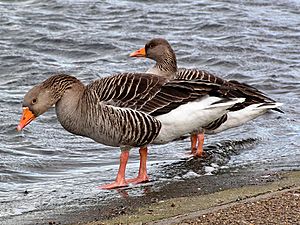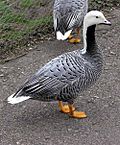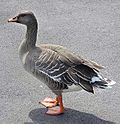Anser (bird) facts for kids
Quick facts for kids Anser |
|
|---|---|
 |
|
| Greylag geese (pair), Anser anser | |
| Scientific classification |
|
| Kingdom: | Animalia |
| Phylum: | Chordata |
| Class: | Aves |
| Order: | Anseriformes |
| Family: | Anatidae |
| Tribe: | Anserini Vigors 1825 |
| Genus: | Anser Brisson, 1760 |
| Type species | |
| Anser anser Greylag goose Linnaeus, 1758
|
|
| Species | |
and see text |
|
| Synonyms | |
|
Chen Boie, 1822 (but see text) |
|
The waterfowl group called Anser includes the grey geese and the white geese. These birds are part of the true geese and swan family, known as Anserinae. You can find Anser geese all over the Northern Hemisphere. They live in open, wet places in cool and temperate areas during the summer. Some even breed further south in warmer regions.
Most of these geese migrate south for the winter. They usually fly to places where the temperature stays between 0 °C (32 °F) and 5 °C (41 °F). There are 11 different kinds of Anser geese alive today. They come in many shapes and sizes. The biggest is the greylag goose, which can weigh up to 4.1 kg (9.0 lb).
All Anser geese have pink or orange legs and feet. Their bills can be pink, orange, or black. They all have white feathers under and over their tails. Many also have some white on their heads. Their bodies, necks, and wings are usually grey or white. They have black or dark main flight feathers on their wings. The three "white geese" (emperor, snow, and Ross's geese) used to be in their own group, Chen. But now, scientists usually put them with Anser. The "black" geese, like the Canada goose, are in a different group called Branta. They have black legs and darker body feathers.
Contents
Understanding Anser Geese
The scientific name Anser was first used by a French zoologist, Mathurin Jacques Brisson, in 1760. The name comes from the Latin word for "goose."
How Geese Are Related
Scientists have studied how different Anser geese are related. It has been tricky because they changed quickly over time. Also, different types of geese often hybridize, meaning they can have babies together. In 2016, a study looked at their DNA to understand their family tree. This helped show how the different species are connected.
| Anser |
|
||||||||||||||||||||||||||||||||||||||||||||||||||||||||||||
Types of Anser Geese
There are 11 living species in the Anser group. Here are some of them:
| Image | Scientific Name | Common Name | Where They Live |
|---|---|---|---|
 |
Anser indicus | Bar-headed goose | Central Asia |
 |
Anser canagicus | Emperor goose | Aleutian Islands, Alaska |
 |
Anser rossii | Ross's goose | North America |
 |
Anser caerulescens | Snow goose | North America |
 |
Anser anser | Greylag goose | Western Europe, Iceland, Norway, Sweden, Finland, Russia, Poland, Hungary, Romania |
 |
Anser cygnoides | Swan goose | Mongolia, northern China, southeastern Russia |
 |
Anser fabalis | Taiga bean goose | northern Europe and Asia |
 |
Anser brachyrhynchus | Pink-footed goose | northwestern Europe, especially Ireland, Great Britain, the Netherlands, western Denmark |
 |
Anser serrirostris | Tundra bean goose | northern Siberia |
 |
Anser albifrons | Greater white-fronted goose | North America, Siberia to Arctic Canada, winters in the United States and Japan |
 |
Anser erythropus | Lesser white-fronted goose | northernmost Asia, rarely breeds in Europe |
The white geese, like the Snow goose (Anser caerulescens), Ross's goose (Anser rossii), and Emperor goose (Anser canagicus), were once thought to be in their own group, Chen. However, most bird experts now agree they belong in Anser.
Ancient Goose Fossils
Many fossils of ancient geese have been found. It's hard to tell exactly which group they belong to just from their bones. But scientists believe that many European goose fossils are from the Anser group. Some fossils from North America are also thought to be Anser geese.
One interesting fossil, Anser pratensis, might have been a unique type of grey goose that could perch in trees!
Geese and People
Anser geese are important to humans in several ways. Two species are especially important because they have been domesticated for farming. European domesticated geese come from the greylag goose. Chinese and some African domesticated geese come from the swan goose. These geese are raised for their meat, eggs, and feathers.
Many wild goose species are hunted. In some places, too much hunting has put certain populations in danger. For example, the lesser white-fronted goose is listed as Vulnerable. This means it is at risk of becoming extinct. The swan goose is also in danger because of too much hunting and loss of its natural home.
On the other hand, some goose populations have grown a lot. This happened after hunting was reduced in the late 1800s and early 1900s. In places like western Europe and North America, many species are now thriving. Sometimes, large groups of geese eating crops in winter can cause problems for farmers.
See also
 In Spanish: Ánsar para niños
In Spanish: Ánsar para niños

